Related Research Articles

A flag is a piece of fabric with a distinctive design and colours. It is used as a symbol, a signalling device, or for decoration. The term flag is also used to refer to the graphic design employed, and flags have evolved into a general tool for rudimentary signalling and identification, especially in environments where communication is challenging. Many flags fall into groups of similar designs called flag families. The study of flags is known as "vexillology" from the Latin vexillum, meaning "flag" or "banner".

Sailing employs the wind—acting on sails, wingsails or kites—to propel a craft on the surface of the water, on ice (iceboat) or on land over a chosen course, which is often part of a larger plan of navigation.

A sailing ship is a sea-going vessel that uses sails mounted on masts to harness the power of wind and propel the vessel. There is a variety of sail plans that propel sailing ships, employing square-rigged or fore-and-aft sails. Some ships carry square sails on each mast—the brig and full-rigged ship, said to be "ship-rigged" when there are three or more masts. Others carry only fore-and-aft sails on each mast, for instance some schooners. Still others employ a combination of square and fore-and-aft sails, including the barque, barquentine, and brigantine.

A sailing vessel's rig is its arrangement of masts, sails and rigging. Examples include a schooner rig, cutter rig, junk rig, etc. A rig may be broadly categorized as "fore-and-aft", "square", or a combination of both. Within the fore-and-aft category there is a variety of triangular and quadrilateral sail shapes. Spars or battens may be used to help shape a given kind of sail. Each rig may be described with a sail plan—formally, a drawing of a vessel, viewed from the side.
Flag terminology is the nomenclature, or system of terms, used in vexillology, the study of flags, to describe precisely the parts, patterns, and other attributes of flags and their display.

Seamanship is the art, knowledge and competence of operating a ship, boat or other craft on water. The Oxford Dictionary states that seamanship is "The skill, techniques, or practice of handling a ship or boat at sea."
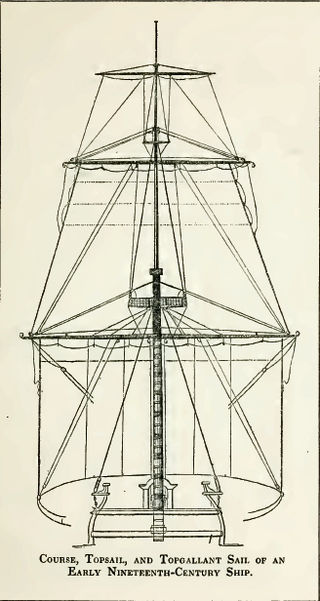
A topsail ("tops'l") is a sail set above another sail; on square-rigged vessels further sails may be set above topsails.
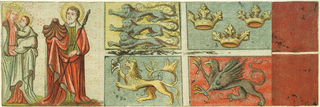
A maritime flag is a flag designated for use on ships, boats, and other watercraft. Naval flags are considered important at sea and the rules and regulations for the flying of flags are strictly enforced. The flag flown is related to the country of registration: so much so that the word "flag" is often used symbolically as a metonym for "country of registration".

A cutter is a name for various types of watercraft. It can apply to the rig of a sailing vessel, to a governmental enforcement agency vessel, to a type of ship's boat which can be used under sail or oars, or, historically, to a type of fast-sailing vessel introduced in the 18th century, some of which were used as small warships.

HMS Java was a British Royal Navy 38-gun fifth-rate frigate. She was originally laid down in 1805 as Renommée, described as a 40-gun Pallas-class French Navy frigate, but the vessel actually carried 46 guns. The British captured her in 1811 in a noteworthy action during the Battle of Tamatave, but she is most famous for her defeat on 29 December 1812 in a three-hour single-ship action against USS Constitution. Java had a complement of about 277, but during her engagement with Constitution she allegedly had 426 aboard, in comparison with her opponent's 475.

Striking the colors—meaning lowering the flag that signifies a ship's or garrison's allegiance—is a universally recognized indication of surrender, particularly for ships at sea. For a ship, surrender is dated from the time the ensign is struck.

The mast of a sailing vessel is a tall spar, or arrangement of spars, erected more or less vertically on the centre-line of a ship or boat. Its purposes include carrying sails, spars, and derricks, giving necessary height to a navigation light, look-out position, signal yard, control position, radio aerial or signal lamp. Large ships have several masts, with the size and configuration depending on the style of ship. Nearly all sailing masts are guyed.

A pilot boat is a type of boat used to transport maritime pilots between land and the inbound or outbound ships that they are piloting. Pilot boats were once sailing boats that had to be fast because the first pilot to reach the incoming ship got the business. Today, pilot boats are scheduled by telephoning the ship agents/representatives prior to arrival.
This glossary of nautical terms is an alphabetical listing of terms and expressions connected with ships, shipping, seamanship and navigation on water. Some remain current, while many date from the 17th to 19th centuries. The word nautical derives from the Latin nauticus, from Greek nautikos, from nautēs: "sailor", from naus: "ship".
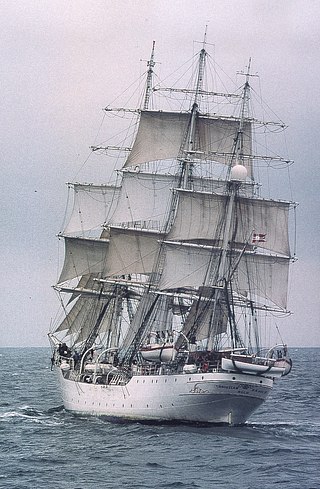
A full-rigged ship or fully rigged ship is a sailing vessel with a sail plan of three or more masts, all of them square-rigged. Such a vessel is said to have a ship rig or be ship-rigged, with each mast stepped in three segments: lower, top, and topgallant.
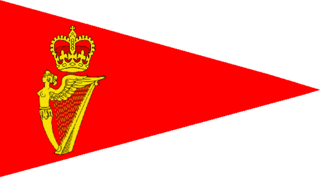
A burgee is a distinguishing flag, regardless of its shape, of a recreational boating organization. In most cases, they have the shape of a pennant.

A foresail is one of a few different types of sail set on the foremost mast (foremast) of a sailing vessel:
Naval flag signalling covers various forms of flag signalling, such as semaphore or flaghoist, used by various navies; distinguished from maritime flag signalling by merchant or other non-naval vessels or flags used for identification.
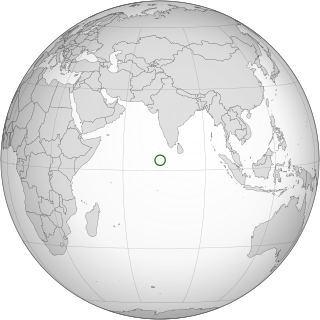
The action of 27 February 1941 was a single ship action between the British cruiser HMS Leander and the Italian auxiliary cruiser Ramb I. It began when Leander ordered an un-flagged freighter to stop for an inspection. The freighter raised the Italian colours and engaged Leander which sank Ramb I shortly after. Most of the Italian crew were rescued and taken to Addu Atoll, then Ceylon. Leander patrolled southwards to investigate more reports of commerce raiders.
This glossary of nautical terms is an alphabetical listing of terms and expressions connected with ships, shipping, seamanship and navigation on water. Some remain current, while many date from the 17th to 19th centuries. The word nautical derives from the Latin nauticus, from Greek nautikos, from nautēs: "sailor", from naus: "ship".
References
- 1 2 3 Rousmaniere, J. (1989). The Annapolis Book of Seamanship (2nd rev. ed.). New York: Simon and Schuster. pp. 366–367. ISBN 978-0-671-67447-2. OCLC 19515016. OL 2187981M.
- 1 2 Maloney, E. S. (1999). Chapman Piloting: Seamanship and Boat Handling (63rd ed.). New York: Hearst Marine Books. pp. 584–585. ISBN 978-0-688-16890-2. OCLC 42282174. OL 7727401M.
- 1 2 3 Broome, J. (1955). Make a Signal! . London: Putnam. pp. 12, 14–15. OCLC 2419205. OL 6173540M.